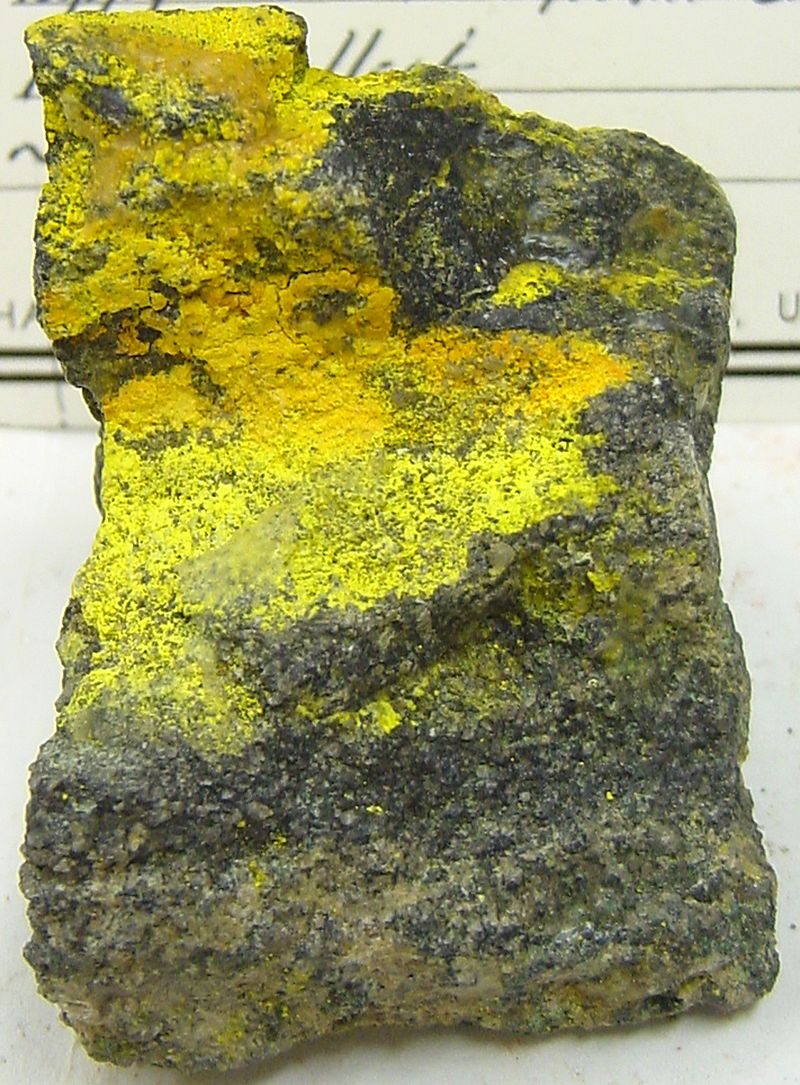Post by 1dave on Apr 16, 2018 19:52:26 GMT -5
Carnotite was first described in 1899 by French scientists M. M. C. Freidel and E. Cumenge, who identified it in specimens from Roc Creek in Montrose County, Colorado, United States.
It was named for Marie Adolphe Carnot (1839 - 1920), a French mining engineer and chemist.

Carnotite in fossilized wood from St. George, Utah
It was named for Marie Adolphe Carnot (1839 - 1920), a French mining engineer and chemist.
en.wikipedia.org/wiki/Carnotite
Carnotite is a potassium uranium vanadate radioactive mineral with chemical formula K2(UO2)2(VO4)2·3H2O. The water content can vary and small amounts of calcium, barium, magnesium, iron, and sodium are often present.
Occurrence

Carnotite from the Happy Jack Mine, Utah
Carnotite is a bright to greenish yellow mineral that occurs typically as crusts and flakes in sandstones. Amounts as low as one percent will color the sandstone a bright yellow. The high uranium content makes carnotite an important uranium ore. It is a secondary vanadium and uranium mineral usually found in sedimentary rocks in arid climates.
In the United States it is an important ore of uranium in the Colorado Plateau region of the United States where it occurs as disseminations in sandstone[2] and concentrations around petrified logs. It also occurs in the U.S. states of Wyoming, Colorado, South Dakota, Nevada, Arizona, and Utah. It also occurs incidentally in Grants, New Mexico and Carbon County, Pennsylvania.[6]
Carnotite is reported in Congo (Kinshasa), Morocco, Australia (Radium Hill) and Kazakhstan.[6] In Pakistan carnotite occurs in the Upper Miocene middle Siwaliks sandstone (Dhokpathan Formation), in the vicinity of Takhat Nasrati, Karak District.[citation needed]
Carnotite is a potassium uranium vanadate radioactive mineral with chemical formula K2(UO2)2(VO4)2·3H2O. The water content can vary and small amounts of calcium, barium, magnesium, iron, and sodium are often present.
Occurrence

Carnotite from the Happy Jack Mine, Utah
Carnotite is a bright to greenish yellow mineral that occurs typically as crusts and flakes in sandstones. Amounts as low as one percent will color the sandstone a bright yellow. The high uranium content makes carnotite an important uranium ore. It is a secondary vanadium and uranium mineral usually found in sedimentary rocks in arid climates.
In the United States it is an important ore of uranium in the Colorado Plateau region of the United States where it occurs as disseminations in sandstone[2] and concentrations around petrified logs. It also occurs in the U.S. states of Wyoming, Colorado, South Dakota, Nevada, Arizona, and Utah. It also occurs incidentally in Grants, New Mexico and Carbon County, Pennsylvania.[6]
Carnotite is reported in Congo (Kinshasa), Morocco, Australia (Radium Hill) and Kazakhstan.[6] In Pakistan carnotite occurs in the Upper Miocene middle Siwaliks sandstone (Dhokpathan Formation), in the vicinity of Takhat Nasrati, Karak District.[citation needed]

Carnotite in fossilized wood from St. George, Utah











